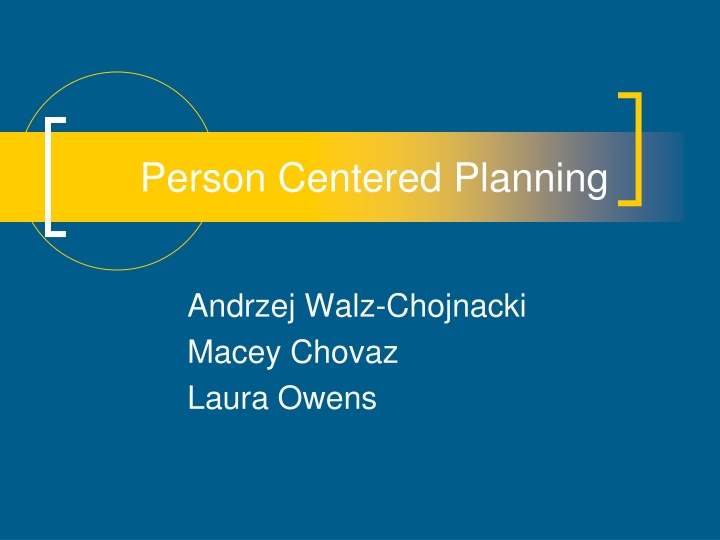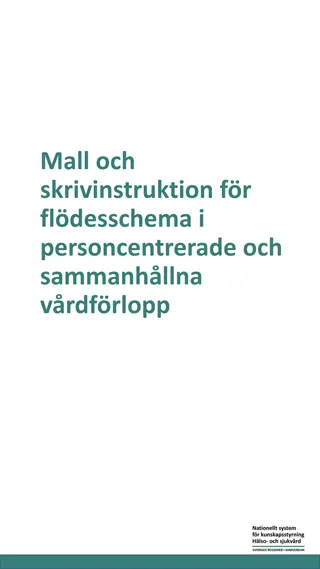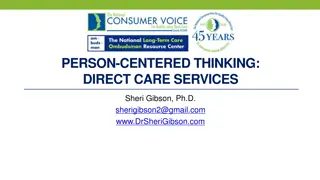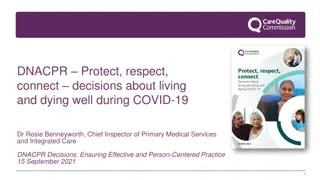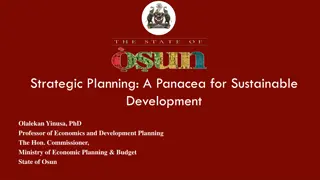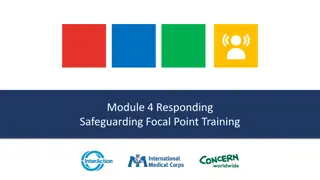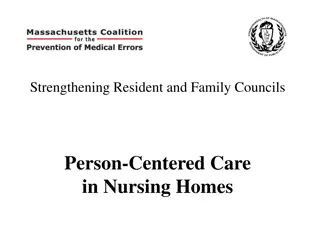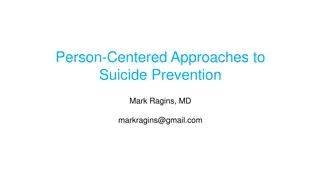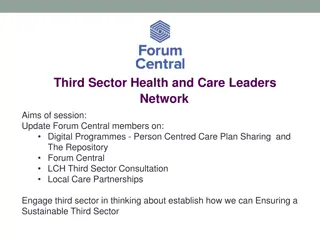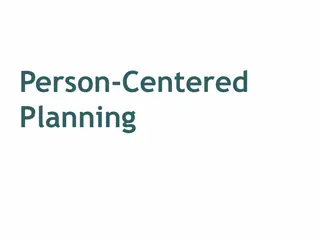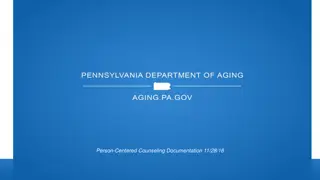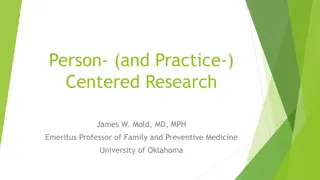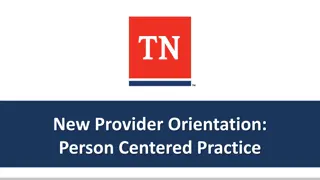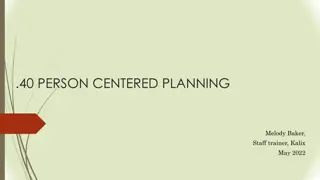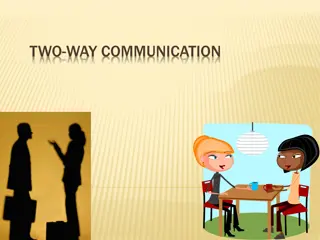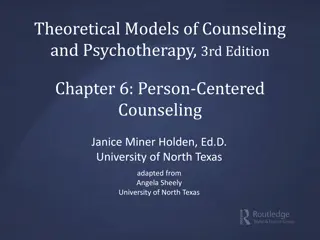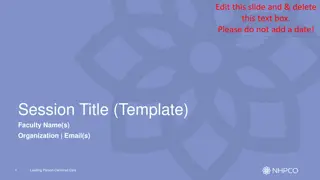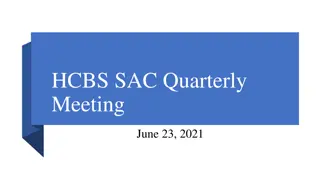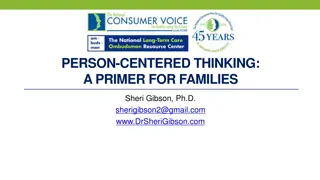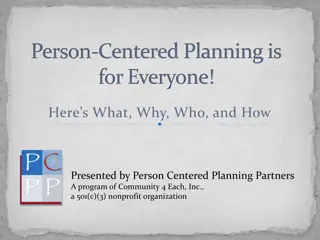Person-Centered Planning for Future Success
Person-centered planning is a creative process that helps individuals, such as young adults, develop plans for how they want to live in the future. It involves aligning visions, goals, and actions while focusing on the person's strengths, relationships, and community involvement. Unlike traditional planning, it values individual capacities and promotes a supportive and reflective environment for decision-making. By moving away from isolation and negative perceptions, person-centered planning aims to enhance community presence, participation, and social roles, ultimately fostering a sense of empowerment and contribution.
Download Presentation

Please find below an Image/Link to download the presentation.
The content on the website is provided AS IS for your information and personal use only. It may not be sold, licensed, or shared on other websites without obtaining consent from the author.If you encounter any issues during the download, it is possible that the publisher has removed the file from their server.
You are allowed to download the files provided on this website for personal or commercial use, subject to the condition that they are used lawfully. All files are the property of their respective owners.
The content on the website is provided AS IS for your information and personal use only. It may not be sold, licensed, or shared on other websites without obtaining consent from the author.
E N D
Presentation Transcript
Person Centered Planning Andrzej Walz-Chojnacki Macey Chovaz Laura Owens
Person-centered planning is a process that uses creative facilitation tools to assist a young adult in developing a plan on how they want to live in the future.
What is Person-Centered Planning? Person-Centered Planning is a way for diverse people, who share a common need to align their . Vision, purposes, and goals. Understanding of their situation and its possibilities for hopeful action. Actions for change, mutual support, personal and team development and learning. John O Brien and Connie Lyle, 2000
What Person-Centered Planning is NOT A one-shot meeting A form to complete A quick fix solution to all problems A guarantee for success A mandate
Planning Traditional Planning Formal assessments Deficiencies & needs Professional Teams Person-Centered Planning Discovering the person Uncovering capacities and gifts Identifying supports and current relationships
Who makes the decision? Beth Mount, 2000 Systems centered approach Spends lots of time planning with little time to take action. Person-Centered Spends lots of time taking action, with regular times to reflect.
Values that guide personal futures planning Beth Mount, 2000 Moving away from: Isolation, separation, activities and schedules. Rejection, loneliness, ignored. Negative reputations, negative self-fulfilling prophecies. Lack of representation, no power. Underproductive, ignored, no resources, low expectations Toward daily experiences which lead to: Community presence Community participation Encouraging valued social roles. Promoting choice Supporting contribution
John OBrien on Person Centered planning Person-centered planning did not ignore disability, it simply shifted the emphasis to a search for capacity in the person, among the person s friends and family, in the person s community, and among service workers.
Planning alone does not change people's lives. John O Brien & Connie Lyle O Brien Person-centered planning offers people a forum for: Discovering a desirable future Negotiating conflicts Creative problem solving Defining and redefining direction Mutual support. A little book about Person Centered Planning, 2000
Benefits of Person Centered planning Driven by the individual Empowers the focus person Creates opportunities for the focus person to become more involved in their communities Focuses on the persons needs and wants and not what systems can provide ~ Mount, 1994.
Limitations of Person Centered Planning Systems limit teams & time Should not be used for everyone Will not automatically create inclusion into the community If done incorrectly can lead to false hopes
How does the process work? The young adult and facilitator invite people who are involved in his/her life or who want to be involved in their life to their future s planning meeting. People attending the meeting should come with the understanding that they are committing to assist the young adult in long term planning of their life.
Creating the team Teams should be created with input from the focus person Committed to the process- don t do it to fulfill a requirement Know the young adult Be willing to step outside their current role
Person-Centered Planning Team Make a commitment and take action to ensure that changes will be accomplished for the focus person. Coordinate support around the life of the individual rather than around the needs of staff and existing services.
Strength based.. Person centered planning looks at a person s strengths and gifts. The dream should be used as the guide for the team and focus person to establish goals. Goals should be positive and possible . Using futures planning allows individuals to create ways to meet their needs- one size does not fit all. Person centered planning gives the focus person a voice. How do you make the system meet the focus person s needs instead of how do we make the person fit into the system.
Learning to listen Listen to the person. Accommodations need to be made according to the person s style of communication. Asking for details gives a better understanding of a persons desires. Listen with care not pity.
How Do You Feel When You have no control over your life You have no voice You feel powerless You have no choices
Accommodations for Communication Know the young adult s form of communication P.E.C.S Pictures Close friend/staff Yes and No questions Non-verbal communication Behavior that demonstrates preferences and choices
Look at things differently There is a story of a man who left seventeen camels to his three sons. He left half the camels to his eldest son, a third to his middle son, and a ninth to his youngest. The three started dividing up their inheritance but soon despaired of their ability to find a solution-because seventeen could not be divided by two or three or nine. The sons approached a wise old women. After pondering the problem the old woman said, See what happens if you take my camel. So then the sons had eighteen camels. The eldest son took his half-that was nine. The middle son took his third-that was six. And the youngest son took his ninth- that was two. Nine and six and two made seventeen. They had one camel left over. They gave it back to the wise old woman. William Ury
Like the seventeen camels, problems, like the ones we are facing now, often seem impossible to solve. Like the wise old woman you will often need to step back, look at the situation from a fresh angle, and find an eighteenth camel. Adapted from: Getting to Yes, William Ury
Everyone has the right to dream It is important to ask questions to fully understand a person s dream. How can we develop a plan that will support the focus person in reaching a portion of their dream? Listen to the dream. What does the dream mean to the focus person?
Getting to know the young individual I like to spend time with Teams should include members who want to be there and members who the focus person feels are important in their lives. Person is more likely to achieve their goals when supported by those that care about them.
Getting to know the individual What I did last year.. Sometimes we get too involved in looking at what did not work to see what was accomplished. Sometimes little things that are important to the focus person go unnoticed to the team members.
Getting to know the individual During my spare time I like to Figuring out what a person likes to do can be key to developing new skills. Everyone needs leisure time how we spend the time is a matter of choice.
Getting to know the individual Things that I am good at Everyone has a gift. Sometimes we need to explore what the person s gift is. Designing services around the person s strengths allows the person to find success in the things they choose to do.
Getting to know the young adult Things that are extremely important to me Ask what is important, this gives the focus person a voice in the planning process. Sometimes teams focus on what is billable as opposed to what is important to the individual.
Getting to know the young adult Things I never want in my life Asking people what they never want in their lives is like asking them what their nightmare is By avoiding a persons nightmare we can get closer to meeting their needs.
Getting to know the young adult My long-term goals for the future are: Setting long term goals helps the focus person look towards the future. Establishing goals assists the focus person in reaching their dreams. The focus person s long term goal should be carried over into the IPP. IPP can assist in monitoring the focus person s progress towards achieving their dreams.
Getting to know the young adult People who support me Creating and sustaining relationships allows for a person to have real inclusion into their communities. Person needs to create relationships with those who want to be involved in their lives. Paid personnel tend not to stay in a person with disabilities life for the long term
Getting to know the young adult What I want to do in the next year and who I would like to help me. By breaking down a person s dreams into short term goals allows the focus person to develop clear plans for them to touch their dreams and avoid their nightmares. Person centered planning allows the focus person to guide the planning process. Do assume everyone desires to help. Be sure to ask who is willing to help.
Getting to know the young adult If I could change things in my life, what would I change? Persons with disabilities have a right to make choices about their lives. Listening to what the focus person desires to change about their lives will allow for supports to be developed that may improve the focus persons quality of life.
Getting to know the young adult What community activities will enable me to pursue interest in a positive way? Information should be used to assist the focus person in becoming part of their communities. Everyone has different interests and planning must be individualized. Person will exhibit less challenging behaviors when they are participating in activities that they find pleasurable.
Choice Preferences reflect what people want, while opportunities reflect what is available. Control is the authority to make use of an opportunity to satisfy a preference. Michael W. Small Revisiting Choice, A little book about Person Centered Planning, Inclusion Press, 2000
Exercise: How do you make choices about your life? Take a few minutes to think about a choice you have made in your life? How did you make a major decision in your life? Did you make a good choice? Did you hear bad advice? Who helped you make your decision?
Teams need to recognize the need for balancing safety issues and allowing the focus person to make a choice. Teams have an ethical responsibility to assure the focus person does not harm themselves or others.
Good support teams assist the focus person in touching their dreams.
Facilitating Person Centered Planning The Facilitator believes the planning process belongs to the focus person The process and content belongs to the person and those who are committed to accompany the person along the journey the plan outlines ~ Marsha Forest, Jack Pearpoint and John o Brien, 2003
Facilitating the Person Center Process Must be willing to not pass judgment Must not be pushy or fall into the role of therapist or social worker Must listen to the focus person Must believe in the process Must be willing to commit to working together to make changes
Essential Lifestyle Planning What are your non negotiables ? What are your strong preferences ? What are your highly desireables ? People who know & care about me say To be successful in supporting me, we must My reputation says If this is going to happen, we must Adapted from Michael Smull, 1991
Components of PCP/PFP Personal profile Personal futures statement Strategies to achieve vision Menu of specific activities, services, and personal commitments Current and needed supports/services Statement of LR and HQ environments Develop action plan
10 conditions that increase the likelihood of implementation. When the person wants life to be different somehow. When the person and team keep focused on capacities. When the person has a specific personal vision. When people are willing to meet on a regular basis to solve problems and are willing to do so over time. When a skilled facilitator is available to support the group over time. When the team includes someone who as a strong commitment to act on behalf of the person. When someone works at building connections to the community. When the person is connected to another person facing similar obstacles. When one human service agency is willing to change. When the person or team has access to people who make decisions about resources. 1. 2. 3. 4. 5. 6. 7. 8. 9. 10. Beth Mount, 2000
Five Essential Outcomes of Person-Centered Planning Being present and participating in community life Gaining and maintaining satisfying relationships Expressing preferences and making choices in everyday life Having opportunities to fulfill respected roles and to live with dignity Continuing to develop personal competencies ~ Kincaid, 1996 1. 2. 3. 4. 5.
